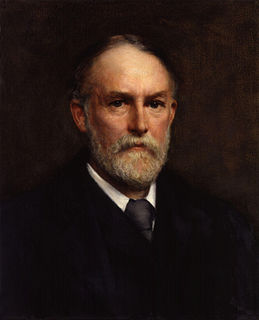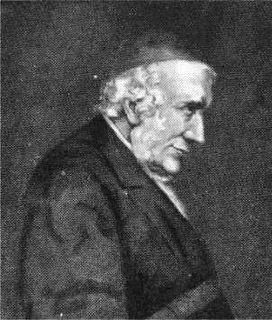Related Research Articles

Frederic William Henry Myers was a British poet, classicist, philologist, and a founder of the Society for Psychical Research. Myers' work on psychical research and his ideas about a "subliminal self" were influential in his time, but have not been accepted by the scientific community. However, in 2007 a team of cognitive scientists at University of Virginia School of Medicine, led by Edward F. Kelly published a major empirical-theoretical work, Irreducible Mind, citing various empirical evidence that they think broadly corroborates Myer's conception of human self and its survival of bodily death.

Julius Charles Hare was an English theological writer.

Richard Chenevix Trench was an Anglican archbishop and poet.

The Oxford Movement was a movement of high church members of the Church of England which eventually developed into Anglo-Catholicism. The movement, whose original devotees were mostly associated with the University of Oxford, argued for the reinstatement of some older Christian traditions of faith and their inclusion into Anglican liturgy and theology. They thought of Anglicanism as one of three branches of the "one, holy, catholic, and apostolic" Christian church. By the 1840s many participants decided that the Anglican Church lacked grace, and converted to Roman Catholicism.

Keswick is an English market town and a civil parish in the Allerdale borough of Cumbria, England. Historically it was in Cumberland, and since 1974 has been in Cumbria. It lies within the Lake District National Park, Keswick is just north of Derwentwater and is four miles from Bassenthwaite Lake. It had a population of 5,243 at the 2011 census.

Grasmere is a village and tourist destination in Cumbria, England, in the centre of the Lake District, named after its adjacent lake. It has links with the Lake Poets: William and Dorothy Wordsworth lived in Grasmere for 14 years and called it "the loveliest spot that man hath ever found." Grasmere lay within the historic county of Westmorland. In 1961, the civil parish had a population of 1,029. That of the Ambleside and Grasmere ward was 4,475 in the 2011 census and estimated at 4,592 in 2019.

Keswick School of Industrial Art (KSIA) was founded in 1884 by Canon Hardwicke Rawnsley and his wife Edith as an evening class in woodwork and repoussé metalwork at the Crosthwaite Parish Rooms, in Keswick, Cumbria. The enterprise, designed to alleviate unemployment, prospered, and within ten years more than a hundred men were attending classes. A new building was erected for the school at a nearby site.

John Kaye was an English churchman.

James Carlile (1784–1854) was a Scottish clergyman from Paisley. He was a joint minister of a Scots church in Dublin and an Irish commissioner of education. He introduced a different style of education in Ireland whereby children of different denominations could go to the same school.
Ernest James Myers, was a British poet, Classicist and author. He was the second son of the Rev. Frederic Myers, author of Catholic Thoughts, and Susan Harriett Myers.

Newlands Church is a 16th-century church situated less than 500 metres west of the hamlet of Little Town, Cumbria, England in the Newlands Valley of the Lake District. Its exact date of origin is unknown, but a map of 1576 shows a "Newlande Chap." on the site.

Harvey Goodwin was an English academic and Anglican bishop, Bishop of Carlisle from 1869 until his death.

Crosthwaite Parish Church is a church at Great Crosthwaite on the outskirts of Keswick in Cumbria, England. It is dedicated to St Kentigern and is the Anglican church of the parish of Crosthwaite. Since 1951 it has been a Grade II* listed building. The church has an evangelical tradition.
John Rouse Bloxam (1807–1891) was an English academic and clergyman, the historian of Magdalen College, Oxford.
Arthur Thomas Myers was a British physician and sportsman. As a tennis player he participated in two Wimbledon Championships and also played first-class cricket.

Robert Aris Willmott was an English cleric and author. Christened Robert Eldridge Aris Willmott, he never used his second Christian name.
Henry Hayman (1823–1904) was a British Anglican priest and educator. Becoming the headmaster of Rugby School, in post from 1870 to 1874, as the successor of Frederick Temple, he was dismissed from the position in a very public controversy.

Greta Hall is a house in Keswick in the Lake District of England. It is best known as the home of the poets Samuel Taylor Coleridge and Robert Southey.

Gerard Thomas Noel (1782–1851) was a Church of England cleric, known as a hymn writer.

The Church of St Mary and St Nicholas is a Church of England parish church in Littlemore, Oxford, Oxfordshire. The church is a grade II* listed building. The church was founded by John Henry Newman, later Cardinal Newman of the Roman Catholic Church, and it became a centre of Anglo-Catholicism.
References
- ↑ "Myers, Frederic (MRS828F)". A Cambridge Alumni Database. University of Cambridge.
- ↑ Hamilton, Trevor (2009). Immortal Longings: F.W.H. Myers and the Victorian search for life after death. Imprint Academic. pp. 9–10. ISBN 978-1-8454-0248-8.
- 1 2 Bott, George (1994). Keswick: The Story of a Lake District Town. Cumbria: Cumbria County Library. p. 145. ISBN 0905404505.
- Lupton, J. H.; Herring, George (2004). "Myers, Frederic (1811–1851)". Oxford Dictionary of National Biography (online ed.). Oxford University Press. doi:10.1093/ref:odnb/19688.(Subscription or UK public library membership required.)
- Richmond, Joan M (2015). Nine Letters from an Artist The Families of William Gillard, Porphyrogenitus, ISBN 978-1-871328-19-6 Amazon